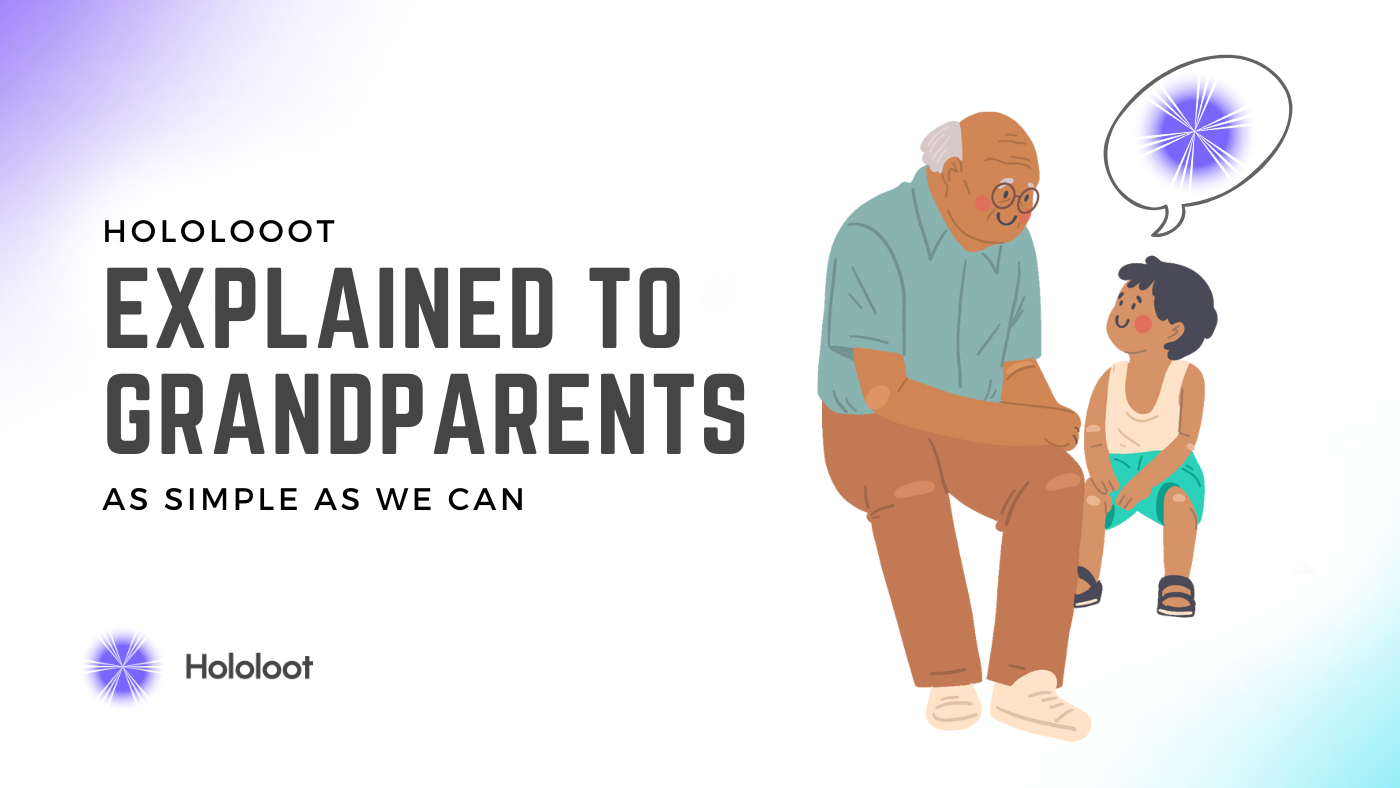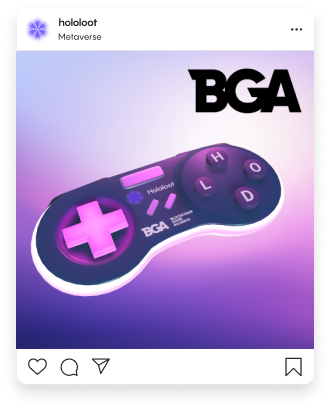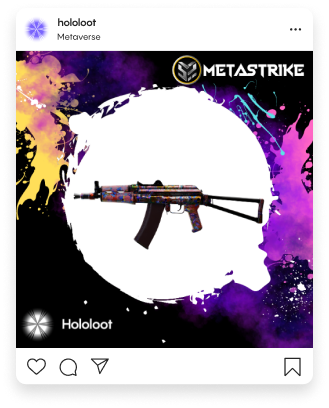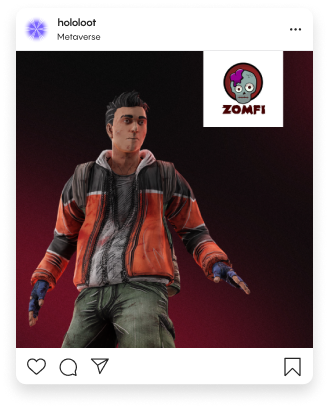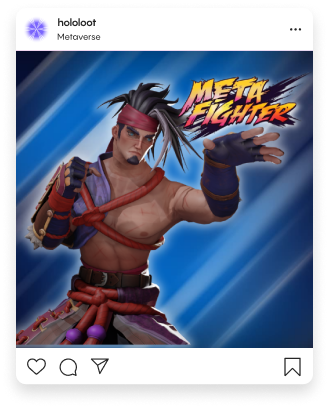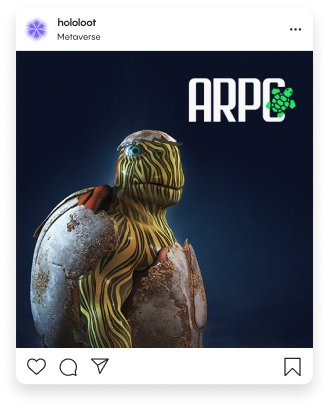We’ve all been there: in a room with our friends or family, attempting to explain how Bitcoin works and what an NFT is. It’s a tough conversation to have, involving cryptography, game theory, economic dynamics and the valuation of abstract concepts like scarcity and cultural impact.
At the start of the year we tried to make these conversations easy for everyone by sharing our guide to the metaverse — a handy article with some simple talking points to get you through those tough conversations. We loved your feedback on that one, so today we’re taking it to the next level.
Welcome to our simple guide to Hololoot.
This article is one of two parts. Today we deal with the basics behind Hololoot: what is Augmented Reality? What is an NFT? And how can I explain these things to my grandma?
Armed with this knowledge, we’ll be ready to address the important question in part two: What is Hololoot?
What is Augmented Reality?
Augmented Reality, or ‘AR’ for short, is a way of perceiving the world with a digital layer superimposed. Imagine putting on a pair of sunglasses that are AR-enabled. What would you see? Well, sunglasses are translucent, so you’ll see what’s in front of you. Take the sunglasses off and you’ll see the exact same thing — although probably a little bit brighter. This is the real world, and AR doesn’t hide it.
But AR sunglasses offer more.
AR means that you can also have digital elements in your field of view. Maybe your glasses are putting big arrows on the footpath directing you to a location. Or if you were riding a bike, your glasses could be displaying your speed or heart rate in the corner of your eye.
AR applications aren’t limited to glasses, and mobile phones are actually where most AR applications live. Your phone’s camera offers a live picture of the world around you, and AR allows you to add digital elements to this world on your phone’s screen.
AR is good for a lot of purposes, and many big names in tech are betting on the sector’s growth over the coming years. In recent articles, we’ve covered some AR use cases that we’re excited about as well as some games that are exciting things with AR: check them out!
What is an NFT?
Non-Fungible Tokens, aka NFTs. Everyone has heard about them, but explaining what they are is a tricky task. Yes, some of them are art. Yes, some of them are very expensive. No, they’re not the only things they are.
Many explanations you read online begin with an explanation of ‘fungibility’, but you don’t really need to understand that to grasp what an NFT is. In essence, an NFT is a unique token that, like all cryptocurrencies, is stored on a blockchain.
Let’s break this down a bit.
NFTs are unique digital objects. Just like objects in real life, no two NFTs can be exactly the same. Sure, the 10 copies of Shrek on VHS that I own all look the same, and all play the exact same movie, but it still stands that those objects aren’t completely identical. They occupy different spaces on my shelf, and even if they are impossible to distinguish with the naked eye, they would still vary in some way on a molecular level.
It’s impossible to have two things that are identical in the real world, but on our computers it’s entirely possible. If I download (legally, of course) a copy of Shrek from the internet, and you download the same file from the same source, we can be reasonably confident that our two files are identical. Even if you made a copy and gave it to a friend, that copy would still be identical.
NFTs allow us to create unique digital items that can’t be simply copied and pasted, a feat achieved by generating something like a serial number and assigning it to items — both real and digital. At the end of the day, that’s all an NFT really is — a serial number, registered on the blockchain, that says what something is and who owns it.
How NFTs are secured relies on the complex cryptographic wizardry that underscores blockchains. But what is important to know is that, once you own an NFT, someone else can’t falsely claim that they also own it. Even though it’s something digital, an NFT can’t be copied and duplicated to create something identical. If the NFT points to something else, for example, a digital file containing unreleased deleted scenes from Shrek, those underlying digital files can be copied. But the NFT saying that I own those files cannot.
NFTs are famous today for their relationship with digital art, but we’ll likely see widespread adoption come through their use with digital contracts. Property deeds, digital identity, work contracts and more will all be assigned NFTs in the near future, simply because these things already exist online, and NFTs make them much more secure.
Bonus round: Why can’t I just screenshot an NFT?
With the crazy prices NFT collections like Bored Ape Yacht Club and CryptoPunks are fetching, you might be tempted to ask why. Has the world gone completely mad? Can’t I just screenshot these overpriced monkey pictures?
Yes, you can. Screenshot away. But that misses the point about what gives an NFT value.
What makes these NFTs valuable are the same forces that make art in general valuable. Duchamp explored this with his Fountain, and Banksy stirs up controversy around this topic all the time.
Speaking of Banksy, have you ever wanted to forge a multi-million-dollar work of art? It’s easy! Banksy predominately uses stencils — go ahead and give it a quick search online and you’ll find them readily available. Print them, cut them out and spray them on your wall. Voilà! Your home is now a museum.
Or is it?
Your version might be indistinguishably identical. You could even do it in the exact same place that one of his works was painted over. It might even fool a fair few people. But it will never be a Banksy.
Provenance is a well-established concept in art, allowing collectors, critics and artists themselves to consider history in the context of a piece. Without provenance, art has little value beyond the aesthetic. This is why some pieces are worth a fortune and why others are effectively worthless.
NFTs give provenance to digital art. Yes, you can copy the art itself, but you can never copy the provenance. And that’s valuable.
(NFTs also often give their holders access to extra services which add another layer of value. You can’t copy that either.)
What does it all mean?
You now know what AR is and what NFTs are, and can confidently explain them to someone who has never used a computer in their life.
But why does it matter?
Hololoot combines the exciting world of AR with the growing sphere of NFTs. We believe that both technologies will become increasingly important in our day-to-day lives, and that at their intersection lies an incredible opportunity.
What is that opportunity, and what even is Hololoot? And, importantly, how can I explain that to my grandparents? Tune in next time for all the details

